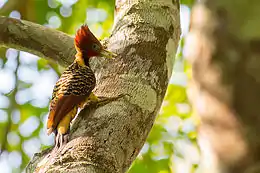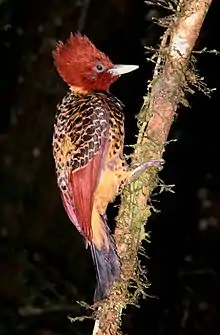Rufous-headed woodpecker
The rufous-headed woodpecker (Celeus spectabilis) is a species of bird in the family Picidae. It formerly included Kaempfer's woodpecker as a subspecies.

| Rufous-headed woodpecker | |
|---|---|
 | |
| Scientific classification | |
| Kingdom: | Animalia |
| Phylum: | Chordata |
| Class: | Aves |
| Order: | Piciformes |
| Family: | Picidae |
| Genus: | Celeus |
| Species: | C. spectabilis |
| Binomial name | |
| Celeus spectabilis | |
It is found in the western Amazon basin in northern Bolivia, far southwestern Brazil (Acre only), eastern Ecuador, and eastern Peru. Its natural habitats are tropical humid forests and woodland. It is often associated with bamboo.
Description
The adult rufous-headed woodpecker is about 27 cm (11 in) in length. The sexes differ in their facial colouring, with the male having a broad crimson patch on the cheeks which the female lacks. The back of the head in both sexes bears a shaggy crest, and the head, crest and throat are a rich chocolate brown or rufous brown. The nape has shaggy, mustard-coloured feathers, and the mantle and back are black with yellow barring. The rump and upper tail-coverts are yellowish, the main flight feathers in the wing are brown and the tail feathers are black. The upper breast is black while the lower breast and the rest of the underparts and flanks are yellow or cream with black barrings, markings or chevrons. The eye is dark, the beak is ivory or yellowish, and the legs are grey.[2]
Distribution and habitat
The rufous-headed woodpecker is found in tropical South America, to the east of the Andes. Its range extends from Ecuador and Peru to northern Bolivia, and the westernmost parts of Brazil. It occurs in humid rain forest at altitudes of up to around 300 m (1,000 ft), especially near rivers and on islands.[1] In Bolivia it is often associated with Guadua, a form of clumping bamboo, while in other parts of its range, it is associated with Gynerium, Heliconia and Cecropia; it largely feeds on ants in the understory and on the forest floor.[2]
Status
The rufous-headed woodpecker has a large range and a presumed large total population. It is generally considered to be uncommon, and the total number of birds is likely to be in slow decline, but the International Union for Conservation of Nature has assessed its conservation status as being of least concern.[1]
References
- BirdLife International (2012). "Celeus spectabilis". IUCN Red List of Threatened Species. 2012. Retrieved 26 November 2013.CS1 maint: ref=harv (link)
- Gorman, Gerard (2014). Woodpeckers of the World: A Photographic Guide. Firefly Books. p. 379–380. ISBN 177085309X.
